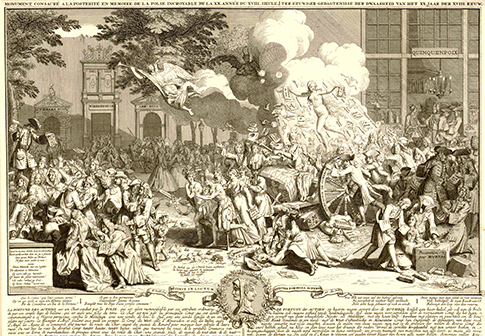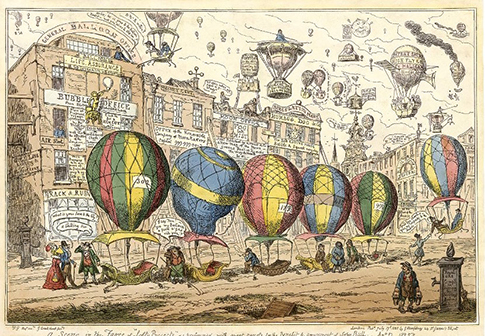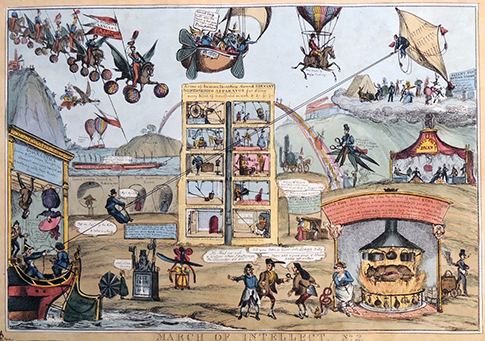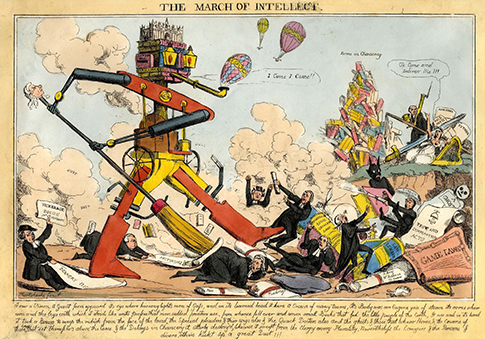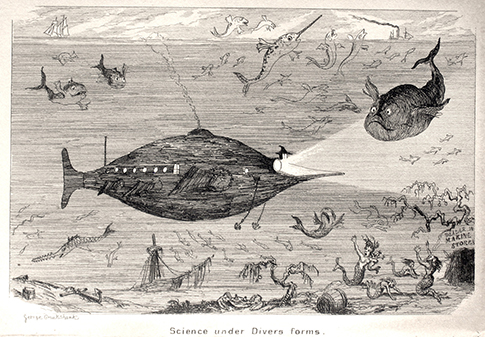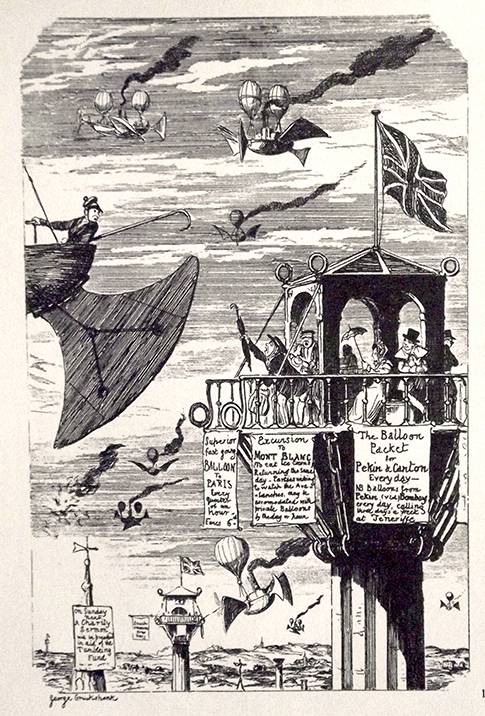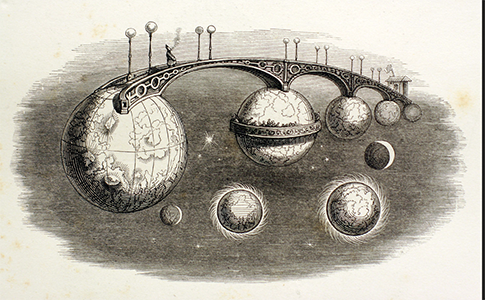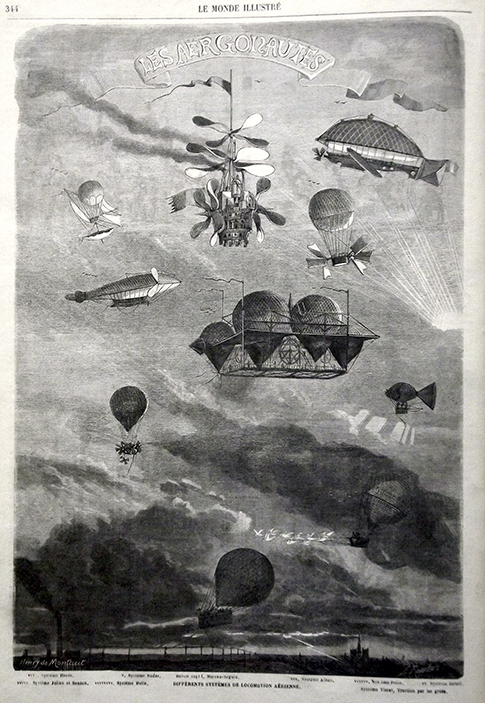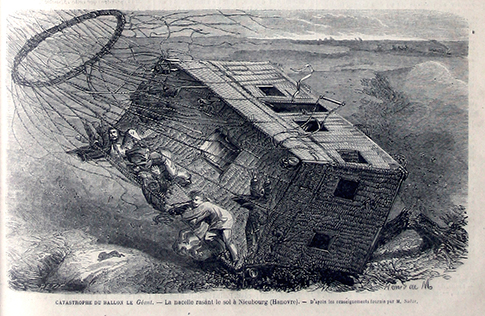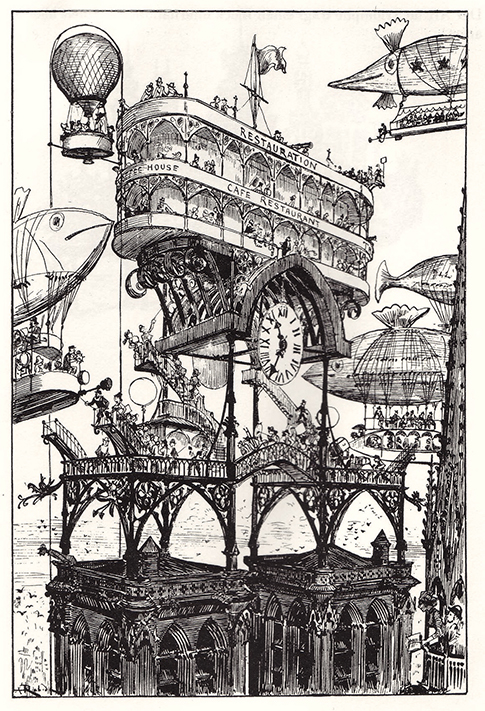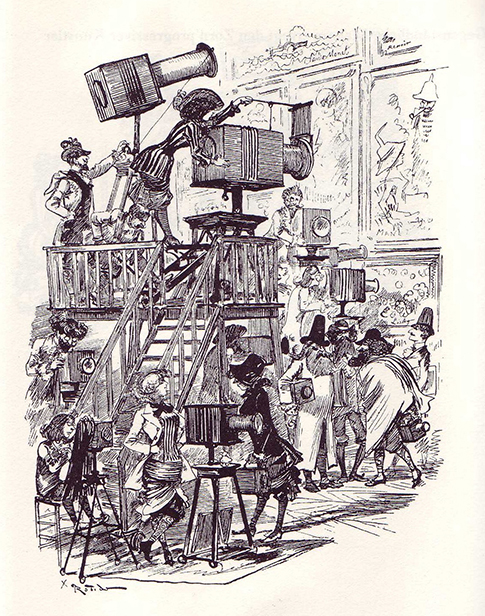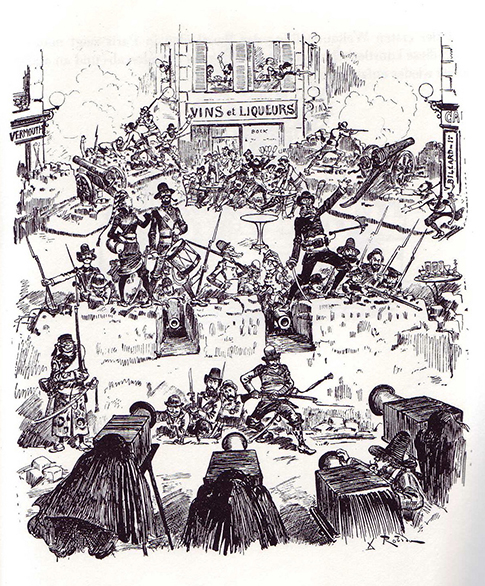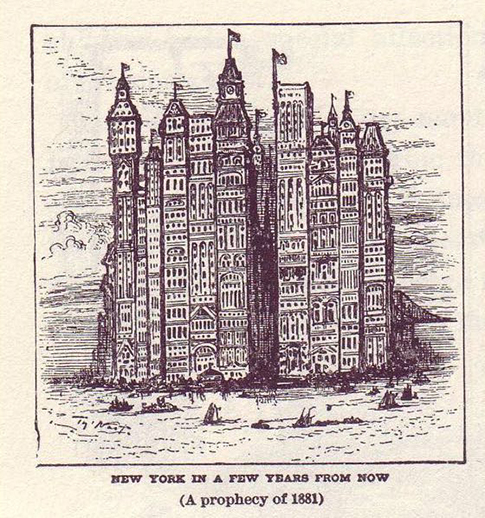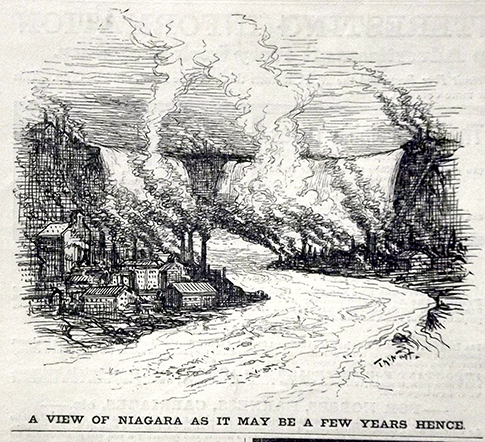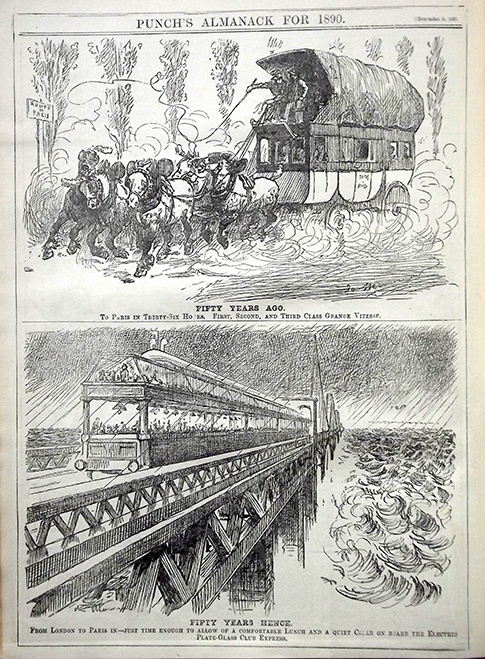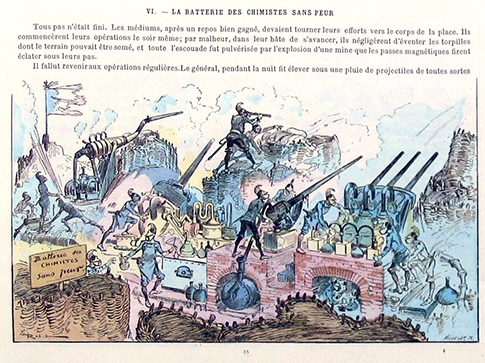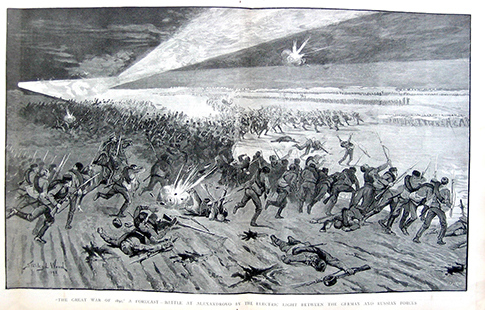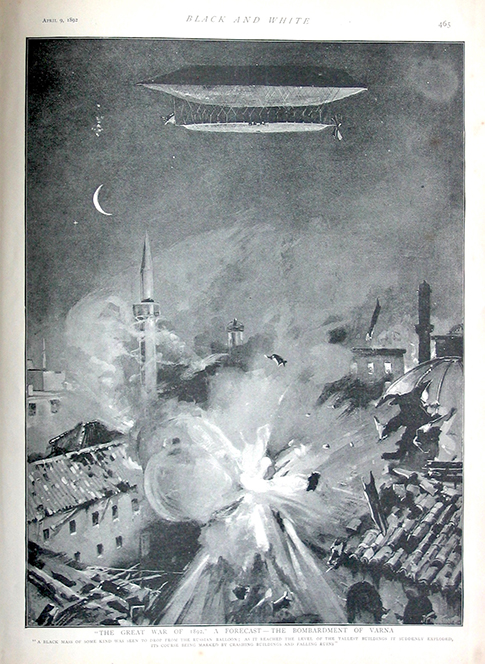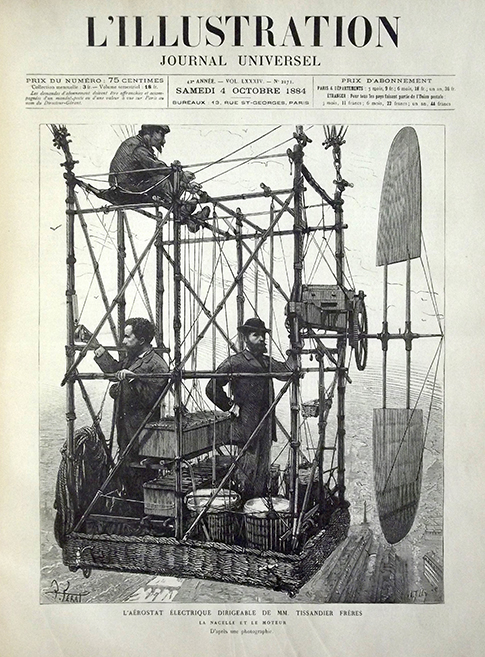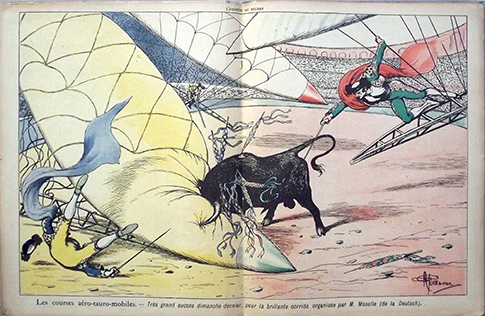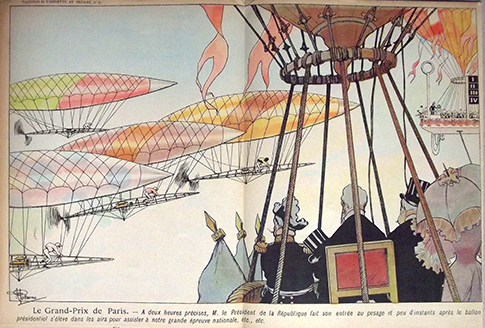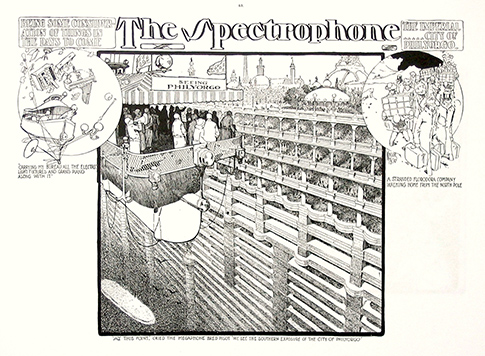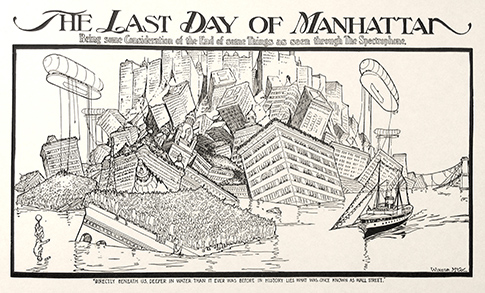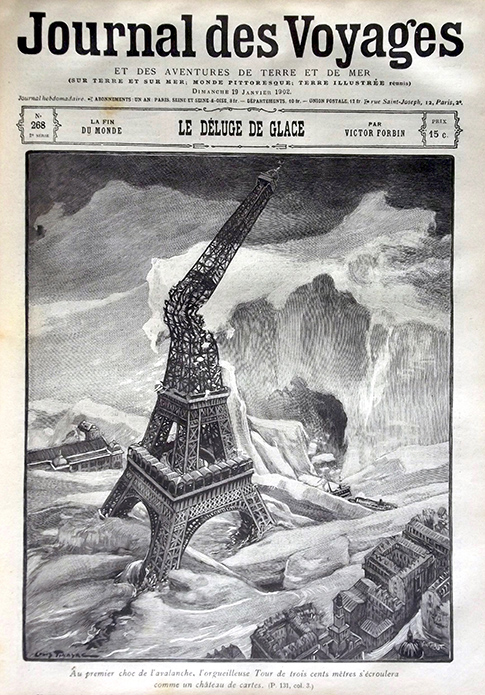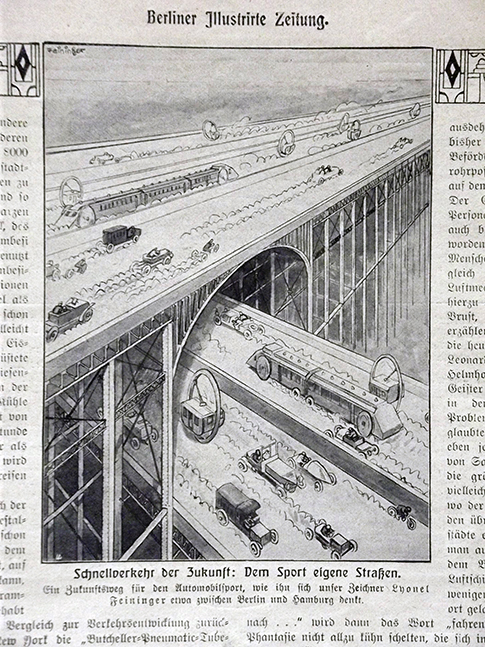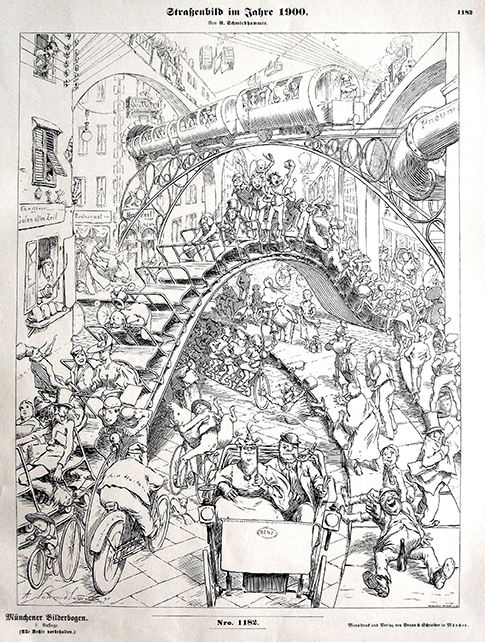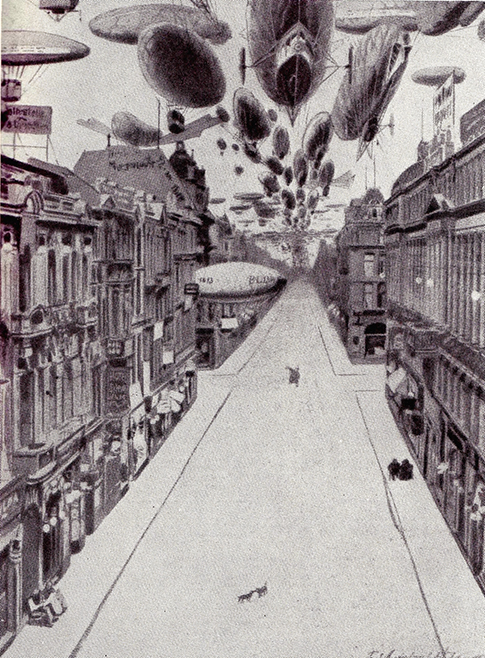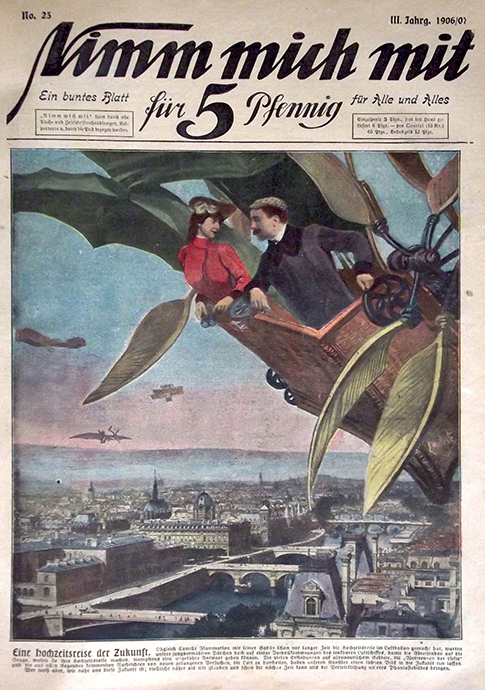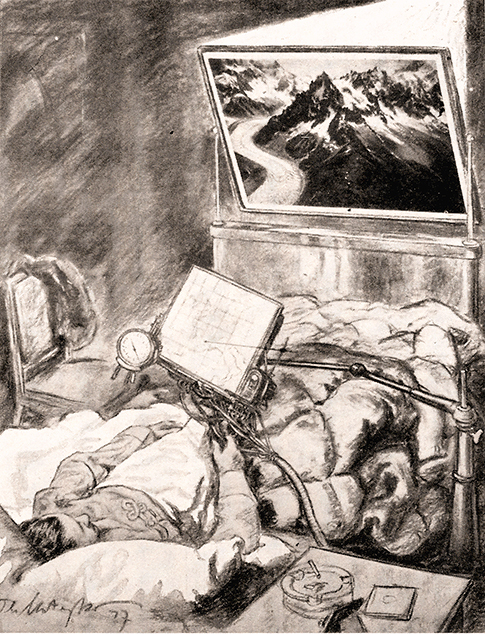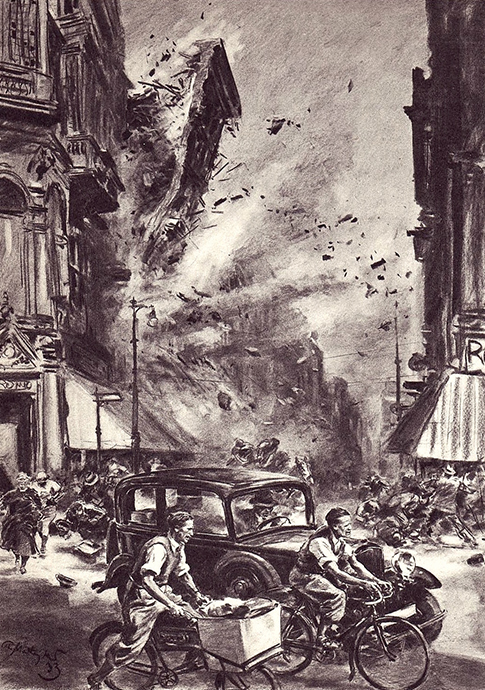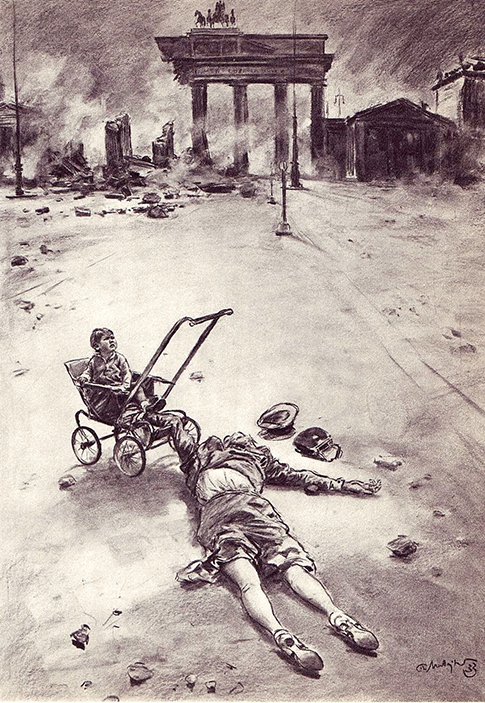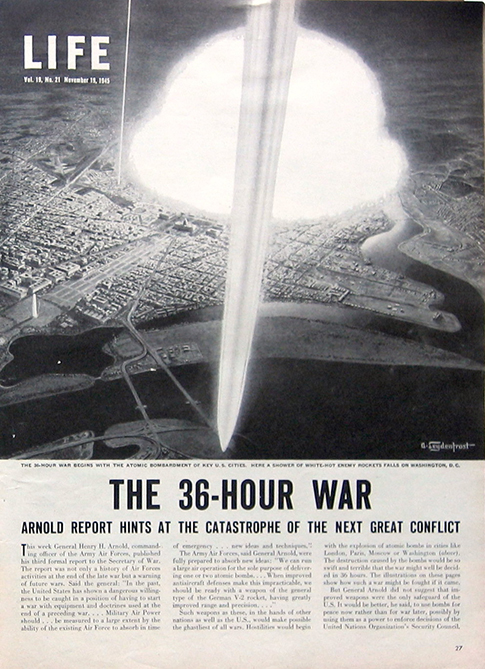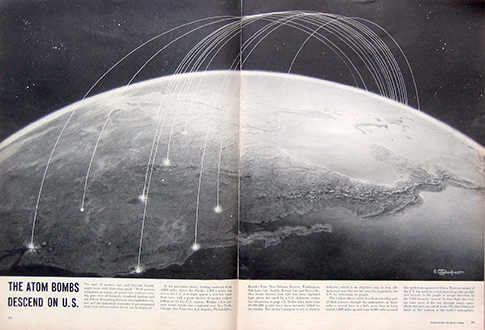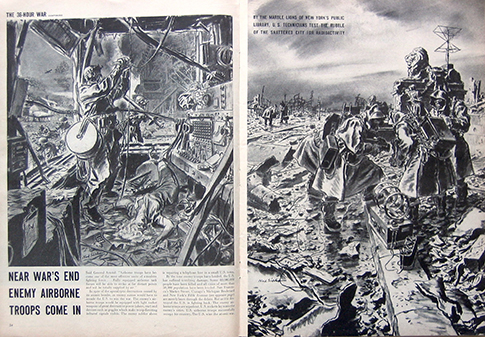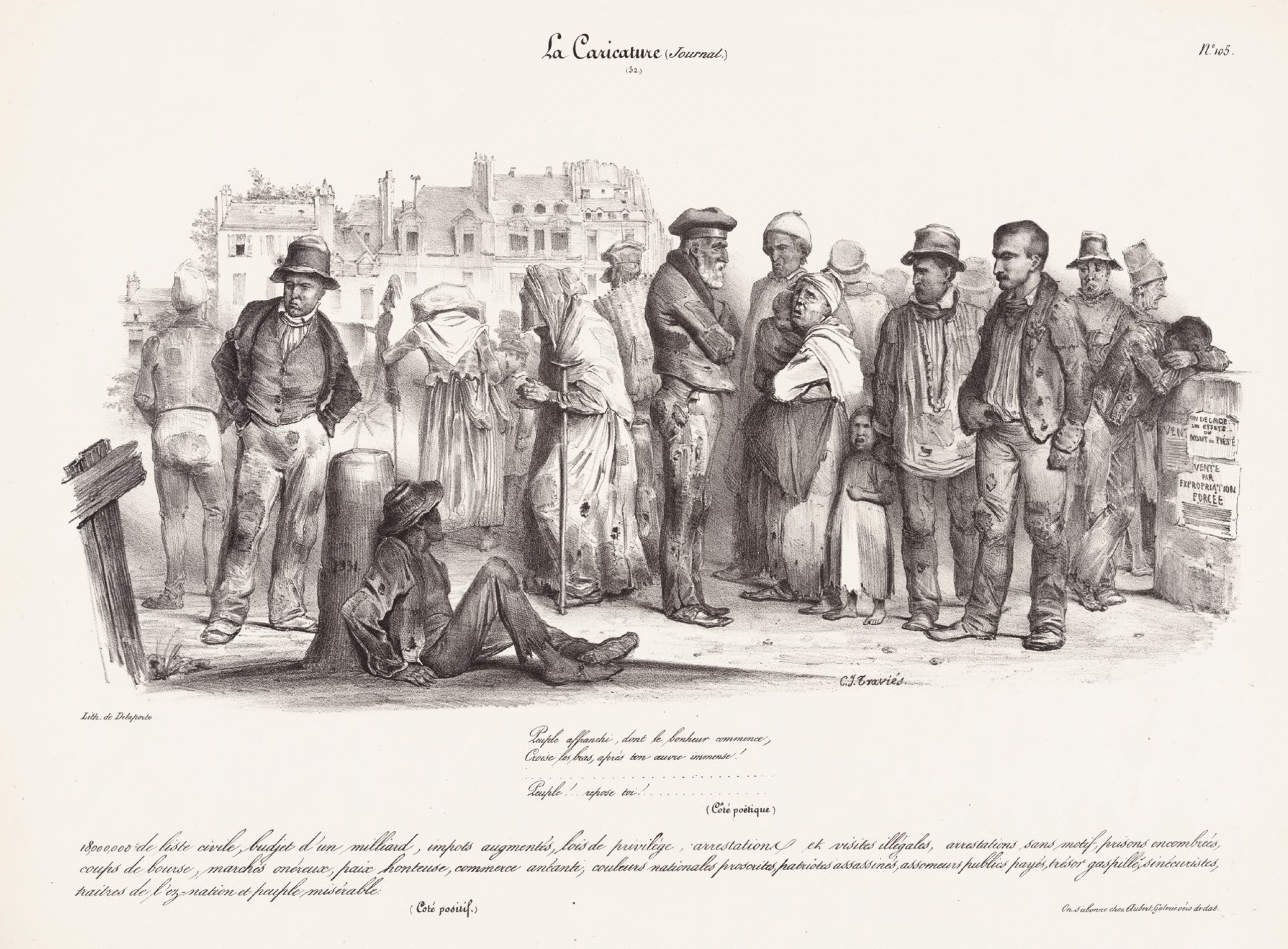Alexander Roob]
[November 5, 2016
Back to the future or the creation of Science-Fiction out of the financial bubble. A Pictorial Gallery
The following commented image show was inspired by the exhibition Technische Paradiese. Die Zukunft in der Karikatur des 19. Jahrhunderts of the museum LA8 in Baden-Baden. The pictorial departs from the selection of this exhibition and combines it with other materials, mostly from the archive of the Melton Prior Institute.
Bernard Picart, Monument consacré à la Postérité, 1720 (Source: Wiki Commons)
Many satirical prints on the financial bubbles of 1720 addressed the discrepancy between the fantastic promises of speculators and the economic reality. Picard’s depiction of the bubble of the French Mississippi Company inspired William Hogarth to his first popular cartoon The South Sea Scheme on the bubble of the British South Sea Company.
George Cruikshank, „Lofty Projects“ as performed with great success for the benefit & amusement of John Bull, 1825 (source: calisphere.org)
George Cruikshank, a successor to Hogarth, had a more effective solution for the visualization of bubbles. He identified the new unbridled capital markets and the windy speculations of the industrial revolution with the hype about the hot air balloons.
William Heath, March of Intellect No. 2, 1829 (Source: Princeton, Graphic Arts Collection)
“Writing to The Times in May 1824, the industrialist and philanthropist Robert Owen remarked that in recent years ‘the human mind has made the most rapid and extensive strides in the knowledge of human nature, and in general knowledge’. He called this ‘the march of intellect’ and believed it had reached a pace that could not be stopped. Building upon this, Henry Brougham established the Society for the Diffusion of Useful Knowledge in 1826, with the purpose of enabling the education of the masses. The phrase ‘the March of Intellect’ became a rallying cry for social and technological progress, its importance being to give all classes the opportunity to better themselves. To others, though, it was seen as giving hope where in fact there was no opportunity and of raising people above their station. Would the March of Intellect benefit society or stagnate it? Amongst those uncertain of its benefits was cartoonist William Heath.” (Mike Ashley, Inventing the future)
Robert Seymour (aka Shortshanks), March of Intellect, London 1828-1830 (Source: The British Museum)
Robert Seymour completed the series of Heath with a brilliant visualization of the unstoppable progress and modernism on the example of the new London University. Like a machine monster, the new institution ruthlessly tramples down outdated scholarship. Mary Shelley’s Frankenstein had been published only ten years before
George Cruikshank, Science under Divers Forms, The Comic Almanack for 1843, London 1844 (MePri-Coll.)
In his popular Comic Almanack series, which appeared from 1835 on for 19 years, Cruikshank was able to demonstrate his broad spectrum from political cartooning and social satire to fantasy illustration.
George Cruikshank, Air-um Scare-um Travelling, The Comic Almanack for 1843, London 1844 (MePri-Coll.)
With his imaginative satires on engineering progress, Cruikshank played a decisive role in the development of the science fiction illustration.
Grandville, The Mysteries of Infinity, Un Autre Monde, Paris 1844 (MePri-Coll.)
Grandvilles fantastic illustrations followed the tradition of the grotesque baroque utopias of the likes of Jacques Callot and Cyrano de Bergerac.
Henry de Montaut, Differentes Systémes de Locomotion Aérienne, Le Monde Illustré, 1863 (MePri-Coll.)
Among the various airships is the “system Nadar”, the giant balloon of the adventurer, inventor, caricaturist and photographer Gaspard-Félix Tournachon aka Nadar who inspired Jules Verne.
Henry de Montaut, Catastrophe du Ballon Le Géant, Le Monde Illustré, Paris 1863 (MePri-Coll.)
Nadar’s enthusiasm for aerial photography declined when his giant balloon Le Géant came down in a field near Hanover. Henry de Montaut, who reconstructed the event according to Nadar’s informations, later illustrated some of the fantastic novels of Nadar’s friend Jules Verne.
Albert Robida, Embaracadère de aéronefs, Le vingtieme siecle, Paris 1883 (MePri-Coll.)
With the publication of his humoresque science fiction trilogy Le vingtieme siecle, Albert Robida became one of the most adapted illustrators of the turn of the century. Progress to him was not, as in the novels of Jules Vernes, the work of elites, but a macrosocial phenomenon.
Albert Robida, Les photopeintres au Louvre, Le vingtieme siecle, Paris 1883 (MePri-Coll.)
Concerning the work of art in the age of mechanical reproduction.
Albert Robida, Les émotions de la guerre civile, Le vingtieme siecle, Paris 1883 (MePri-Coll.)
In this burlesque vision about the future media war, Robida worked on his experiences as a graphic reporter during the barricade battles of the Paris Commune.
Thomas Nast, New York in a few years from now, Harper´s Weekly 1881 (MePri-Coll.)
In contrast to the fantastic visions of the likes of Jules Vernes and Albert Robida, Nast’s outlook was rather prosaic and pessimistic.
Thomas Nast, A view from the Niagara as it maybe a few years hence, Harper´s Weekly 1882 (MePri-Coll.)
Nast combined his prognosis with a critique of the North American megalomania and a campaign against environmental pollution that he had initiated in connection with deaths at Hunter’s Point’s industrial facilities.
George du Maurier, Fifty years hence, Punch´s Almanach for 1890 (MePri-Coll.)
Du Maurier was especially known for his subtle social satires. His friend, Henry James, however, valued him much more as a graphic visionary and a master of the fantastic.
Albert Robida, Les batterie des chimistes sans peur, La Guerre au vingtieme siecle, 1883 (MePri-Coll.)
In his book on the warfare of the coming century, Robida already foresaw the use of chemical weapons.
Stanley Llewellyn Wood nach Frederic Villiers, „The Great War of 1892“, A Forecast – Battle of Alexandrovo by the electric light between the German and Russian forces, Black and White, London 1892 (MePri-Coll.)
The graphic war correspondent Frederic Villiers was one of the most prominent members of a military-strategical team of experts who mapped out a much-admired scenario of a great war for the illustrated magazine Black and White, a great war, which was said to happen “likely in the immediate future.”
Fréderic Villiers, „The Great War of 1892“, A Forecast – The bombardement of Varna, Black and White, London, 1892 (MePri-Coll.)
This announced World War would be triggered by an assassination attempt in the Balkans. The course of war, designed by this first modern Docufiction, was very similar to the chain reaction that led twenty-two years later to the First World War. It was, however, difficult to foresee the destruction of future armament technology.
Jules Férat, Auguste Tilly (sc.), L´Aerostat électrique dirigeable de MM. Tissandier frères, L´ Illustration, Paris 1884 (MePri-Coll.)
As an illustrator of Jules Verne, Jules Férat was well equipped to visualize the journey of the brothers Tissanier in their electric airships effectively. The missing photographic original was presumably a studio shot, which the draftsman had combined with a topographical aerial photography.
Albert Guillaume, Les courses aero-tauro-mobiles, L`Assiette au beurre, 1901 (MePri-Coll.)
For a special issue on airship aviation, the Art Nouveau-illustrator Albert Guillaume picked up motifs from Cruikshank and Robdia and refined them in an effective way.
Albert Guillaume, Le Grand-Prix de Paris, L`Assiette au beurre, 1901 (MePri-Coll.)
Winsor McCay, The Spectrophone: The Imperial City of Philyorgo, Los Angeles Herald, Los Angeles 1904 (Source: California Digital Newspaper Collection)
At the height of his career as a comic artist, Winsor McCay illustrated the humoresque science fiction series The Spectrophone of the satiricalist John Kendrick Bangs with a series of fantastic images. The influences of Cruikshank, Robida and Nast were unmistakable.
Winsor McCay, The Spectrophone: The Last Day of Manhattan, New York Herald, New York, 1905 (Source: Rockwell Center)
In the 44th century, according to Bangs, the American east coast has become a single trade metropolis called Philyorgo. This new center of the universe ultimately perishes by its hypertrophy and finally sinks into the sea.
Louis Tinayre, de Deluge de Glace, Journal des Voyages, 1902 (MePri-Coll.)
Apocalyptic visions of the future had high-growth around the turn of the century. This is the illustration of a prognosis of the popular scientific author Victor Forbin, who prophesied a great glacier flood.
Lyonel Feininger, Schnellverkehr der Zukunft , Berliner Illustrirte Zeitung, Berlin, 1905 (MePri-Coll.)
Lyonel Feininger was one of the leading German press artists of the turn of the century. Apart from political cartooning, the burlesque utopian genre a la Robida and McCay belonged to his specialties.
Arpad Schmidhammer, Straßenbild im Jahre 1900, Münchner Bilderbogen Nr. 1182 (MePri-Coll.)
Fritz Koch, Die Leipziger Strasse der Zukunft, Berliner Illustriert Zeitung 1905 (MePri-Coll.)
The versatile Fritz Koch began his career at the Berliner Illustrite Zeitung in 1904. Under the name Koch-Gotha he then became the most popular German illustrator.
Anon., Die Hochzeitsreise der Zukunft, Nimm mich mit, 1906 (MePri-Coll.)
Along with its model, the French Le Petit Jounral, the socialliberal weekly Nimm mich mit counted on the effect of a spectacular colored title sheet and thus became the leading German Faits divers-magazine.
Theo Matejko, Besichtigung der Welt vom Bett aus durch den Fernseher, Berliner Illustrirte Zeitung, 1928 (MePri-Coll.)
Theo Matejko’s prediction of a media future has meanwhile proved to be fairly precise, at least as far as design is concerned.
Theo Mateijko, Zeichnung 1933, in: “Bombs over us”, Prophetic drawings by a German Artist, Life Magazine 1939 (MePri-Coll.)
In 1933 Theo Matejko drew the horror scenario of a devastated air war under the title of Bombs over Berlin.
Theo Mateijko, Zeichnung 1933, in: “Bombs over us”, Prophetic drawings by a German Artist, Life Magazine 1939 (MePri-Coll.)
Six years later, when Matejko´s series was reprinted in American Life-Magazine, his visions had already been caught up by reality.
Alexander Leydenfrost, The 36-Hour War, Atom Bombs descend on U.S., Life Magazine 1945 (MePri-Coll.)
Shortly after the end of the Second World War Life– Magazine published a docufiction about the possible course of an impending nuclear war. The scenario was based on an official army report. The extensive contribution was illustrated by sci-fi illustrator Alexander Leydenfrost and the well-known comic artist Noel Sickles
Alexander Leydenfrost, The 36-Hour War, Atom Bombs descend on U.S., Life Magazine 1945 (MePri-Coll.)
Noel Sickles, The 36-Hour War, Atom Bombs descend on U.S., Life Magazine 1945 (MePri-Coll.)
